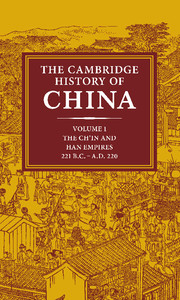Book contents
- Frontmatter
- Introduction
- 1 The state and empire of Ch'in
- 2 The Former Han dynasty
- 3 Wang Mang, the restoration of the Han dynasty, and Later Han
- 4 The conduct of government and the issues at stake A.D. 57–167
- 5 The fall of Han
- 6 Han foreign relations
- 7 The structure and practice of government
- 8 The institutions of Later Han
- 9 Ch'in and Han law
- 10 The economic and social history of Former Han
- 11 The economic and social history of Later Han
- 12 The religious and intellectual background
- 13 The concept of sovereignty
- 14 The development of the Confucian schools
- 15 Confucian, Legalist, and Taoist thought in Later Han
- 16 Philosophy and religion from Han to Sui
- Bibliography
- Glossary-Index
- Map 7 The Han empire, 143 b.c.
- Map 8 The Han empire, 108 b.c
- Map 9 The Han empire, a.d. 2
- Map 12 The Han empire, a.d. 140">
- References
6 - Han foreign relations
Published online by Cambridge University Press: 28 March 2008
- Frontmatter
- Introduction
- 1 The state and empire of Ch'in
- 2 The Former Han dynasty
- 3 Wang Mang, the restoration of the Han dynasty, and Later Han
- 4 The conduct of government and the issues at stake A.D. 57–167
- 5 The fall of Han
- 6 Han foreign relations
- 7 The structure and practice of government
- 8 The institutions of Later Han
- 9 Ch'in and Han law
- 10 The economic and social history of Former Han
- 11 The economic and social history of Later Han
- 12 The religious and intellectual background
- 13 The concept of sovereignty
- 14 The development of the Confucian schools
- 15 Confucian, Legalist, and Taoist thought in Later Han
- 16 Philosophy and religion from Han to Sui
- Bibliography
- Glossary-Index
- Map 7 The Han empire, 143 b.c.
- Map 8 The Han empire, 108 b.c
- Map 9 The Han empire, a.d. 2
- Map 12 The Han empire, a.d. 140">
- References
Summary
THE WORLD ORDER OF HAN CHINA: THEORY AND PRACTICE
In 219 B.C. the First Emperor of Ch'in decided to glorify the crowning success of his imperial career by erecting a number of inscribed stone monuments in various places on the east coast along the route of his first imperial tour of inspection. In one of the stone inscriptions (in Lang-yeh, modern Shantung) the emperor expressed his profound gratification that he had unified the entire civilized world known to the Chinese of the day. But the inscription was after all a public document, written with every intention to arouse the sense of solidarity of the newly unified empire. It therefore cannot be taken as representing the First Emperor's geographical conception of the world. Under the influence of the geographical speculation of Tsou Yen (305–240? B.C.), the First Emperor shared the belief with other rulers of the Warring States period that there were lands beyond the seas where “immortality drugs” could be obtained. In fact, it was also in 219 B.C. that the First Emperor sent Hsu Fu Shih (also called Hsu Fu) to sea in search of the fabled islands known as P'eng-lai, Fang-chang, and Ying-chou.
Tsou Yen's theory
According to Tsou Yen's theory, there are nine large continents (ta chiuchou) in the world, and each is further divided into nine regions. The nine continents are separated from one another by vast oceans, and the nine regions of each continent are also separated from one another by a circling sea. China, known as the Spiritual Continent of the Red Region (ch'ih-hsien shen-chou), constitutes but one of the nine regions of a large continent.
- Type
- Chapter
- Information
- The Cambridge History of China , pp. 377 - 462Publisher: Cambridge University PressPrint publication year: 1986
References
- 44
- Cited by

